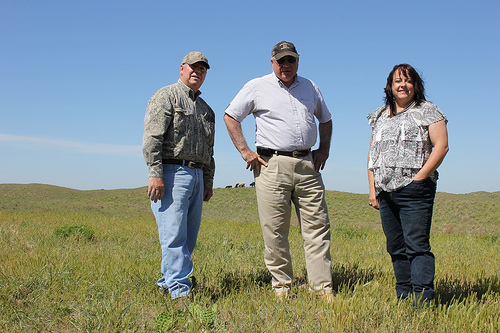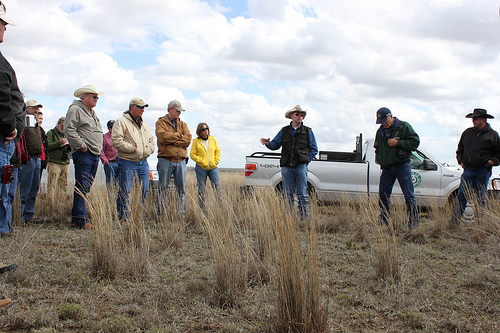
Steve Barlow standing in the longleaf pine forest that he is restoring.
Levy County, on Florida’s “Nature Coast,” is home to a variety of ecosystems, from dense hardwood forests and marsh lands to sand hills and Gulf Coast waters.
The historic Suwannee River borders the north end of the county, while the meandering Withlacoochee River winds through the southern part. Both eventually drain into the Gulf of Mexico, and runoff from agricultural land ending up in the two rivers can carry soil, pesticides and nutrients to the Gulf. Read more »

Ranchers who are protecting the lesser prairie-chicken while improving their operations: Tom Turner (left), Glen Mull, and Amy Harter.
A Kansas family and their neighbor are working with USDA’s Natural Resources Conservation Service (NRCS) to increase habitat for the lesser prairie-chicken—while also benefiting their grazing lands.
Glen Mull and his daughter, Amy Harter, collaborate with Tom Turner to co-manage the grassland they own and the grassland he manages next door. Together, the Mulls and Turner have enrolled roughly 3,000 acres in Edwards and Stafford counties in the Lesser Prairie Chicken Initiative. Read more »

L.H. Webb, a rancher in Pampa, Texas, addresses the group at the training on his ranch to explain the management practices he has implemented to benefit the lesser prairie-chicken.
Cattle ranchers in the Texas Panhandle are interested in raising more than just cattle and grass. They also want to raise chickens—lesser prairie-chickens, to be exact!
The lesser prairie-chicken is a ground-nesting bird native to the mixed-grass prairies of the Texas panhandle, Colorado, Kansas, New Mexico and Oklahoma. Lesser prairie-chickens are known for the unique mating dance performed by the colorful males. Read more »

Gopher tortoise laying eggs on freshly cultivated field.
Gopher tortoises are fairly elusive creatures. Usually the only sign you see of them is their burrows or ravaged foliage.
But recently a Mobile, Ala., tortoise allowed Marshall Colburn, a Soil Conservation Technician with USDA’s Natural Resources Conservation Service (NRCS), a rare, up-close-and-personal moment as she laid her eggs in a freshly cultivated field. Read more »

Ford knows the importance of protecting the natural resources on his land through conservation, so he is able to continue ranching and is able to pass the land onto future generations. Cross fencing and pasture rotation are some of the tools Ford uses to help keep his land healthy.
For Texas rancher Dallas Ford and other Gulf Coast landowners, the Gulf of Mexico Initiative means an opportunity to make a positive difference not only on their lands, but also in the inland waters that flow into the Gulf of Mexico.
The Gulf of Mexico Initiative (GoMI) is a new program of USDA’s Natural Resources Conservation Service (NRCS) and many partners. It is designed to help producers in Alabama, Florida, Louisiana, Mississippi and Texas improve water quality and ensure sustainable agriculture production. Read more »

NRCS Earth Team volunteers and a Colorado state biologist enjoy lunch in the field during a bird count of the Gunnison sage-grouse in a remote section of high desert. From left, Robert Bright, Michelle Collins, Stephanie Steinhoff, Jenny Nehring and Elinor Laurie.
This spring, Earth Team volunteers with USDA’s Natural Resources Conservation Service (NRCS) surveyed approximately 300 hundred acres of remote Bureau of Land Management (BLM) and private lands north of Villa Grove, Colo., looking for Gunnison sage-grouse, a ground-dwelling bird considered a keystone species in this habitat. Read more »






